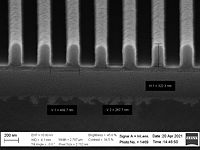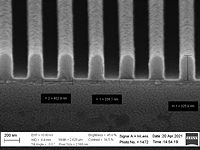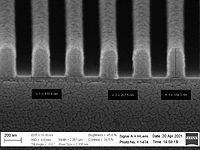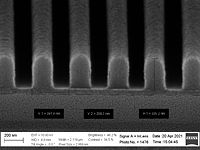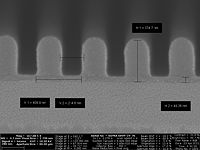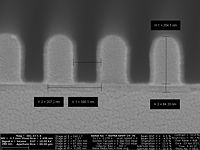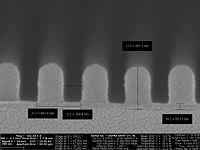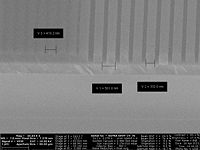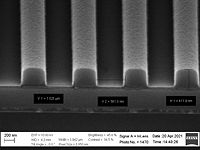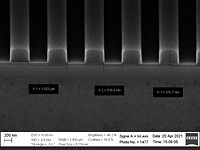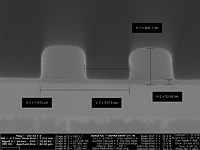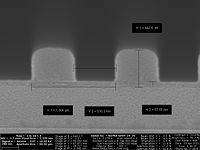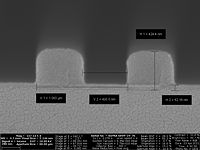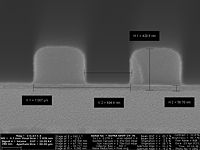Specific Process Knowledge/Etch/DRIE-Pegasus/Pegasus-4/SiO2 Etch: Difference between revisions
| Line 1: | Line 1: | ||
==SiO2 Etch using resist as masking material== | ==SiO2 Etch using resist as masking material== | ||
I | ''This section is done by Berit Herstrøm @Nanolab.dtu if nothing else is stated'' | ||
I have do some development of a SiO2 etch with resist as masking material. I have found this fairly good recipe. For now it is the standard SiO2 etch recipes but I might change the "Standard recipe" a a later time if I find a better one. If you need to etch deeper than 1 micrometer then I advise you to split the etch in several runs with O2 cleans in between (3min TDESC Clean) or else it seems like the the etch rate is going down over time. | |||
*[[/SiO2 etch with resist mask|Click here for more results on the process development on SiO2 etch with DUV resist mask]] | *[[/SiO2 etch with resist mask|Click here for more results on the process development on SiO2 etch with DUV resist mask]] | ||
Revision as of 11:44, 27 January 2023
SiO2 Etch using resist as masking material
This section is done by Berit Herstrøm @Nanolab.dtu if nothing else is stated I have do some development of a SiO2 etch with resist as masking material. I have found this fairly good recipe. For now it is the standard SiO2 etch recipes but I might change the "Standard recipe" a a later time if I find a better one. If you need to etch deeper than 1 micrometer then I advise you to split the etch in several runs with O2 cleans in between (3min TDESC Clean) or else it seems like the the etch rate is going down over time.
- Recipe name: SiO2_res_10, Recipe no. 10: C06445_02 coil_2500W, platen:300W, He/C4F8= 17.5, C4F8/H2=1, Pressure:8.8mTorr, C4F8:25.6sccm, He:448.7sccm, H2:25.6sccm, 3:56 min
-
0.4µ/0.2µ
Bad lithography -
0.5/0.25µ
Etch depth: 652 nm
Resist left: 456 nm -
1µ/0.5µ:
Etch depth: 855 nm
Resist left: 487 nm -
2µ/1µ:
Etch depth: 952 nm
Resist left: 487 nm -
4µ/2µ:
Etch depth: 1106 nm
Resist left: 487 nm -
0.8µ/0.2µ
Etch depth: 867 nm
Resist left: 426 nm -
1.0µ/0.25µ:
Etch depth: 893 nm
Resist left: 460 nm -
4µ/1µ:
Etch depth: 1033 nm
Resist left: 473 nm
SiO2 Etch using aSi as masking material
I am now starting up development of SiO2 etch using aSi as masking material.
The samples I use are:
- 6" Si afters with oxide (2µm),
- aSi (~300nm),
- Neg. DUV reist (~60nm barc, ~350 nm resist)
- Reticle: Danchip/Triple-D
- Dose 230 J/m2
First I need to make sure that the resist work for pattering the aSi layer is good. If the resist is not good the final etch will also not be good.
DUV optimization
Dose test with the doses (J/m2): 200, 210, 220, 230, 240, 250, 270, 280 The aim was to get good line for 400nm pitch/200nm lines
- 400nm pitch 200 nm lines
-
200 J/m2 400nm/268nm
-
210 J/m2 400nm/239nm
-
220 J/m2 400nm/208nm
-
230 J/m2 400nm/209nm
-
240 J/m2 400nm/215nm
-
250 J/m2 400nm/207nm
-
260 J/m2 400nm/188nm
-
270 J/m2 400nm/155nm
-
280 J/m2 400nm/0nm
- 1000nm pitch 500 nm lines
-
210 J/m2 1000nm/581nm
-
230 J/m2 1000nm/517nm
-
240 J/m2 1000nm/518nm
-
250 J/m2 1000nm/510nm
-
260 J/m2 1000nm/493nm
-
270 J/m2 1000nm/494nm









